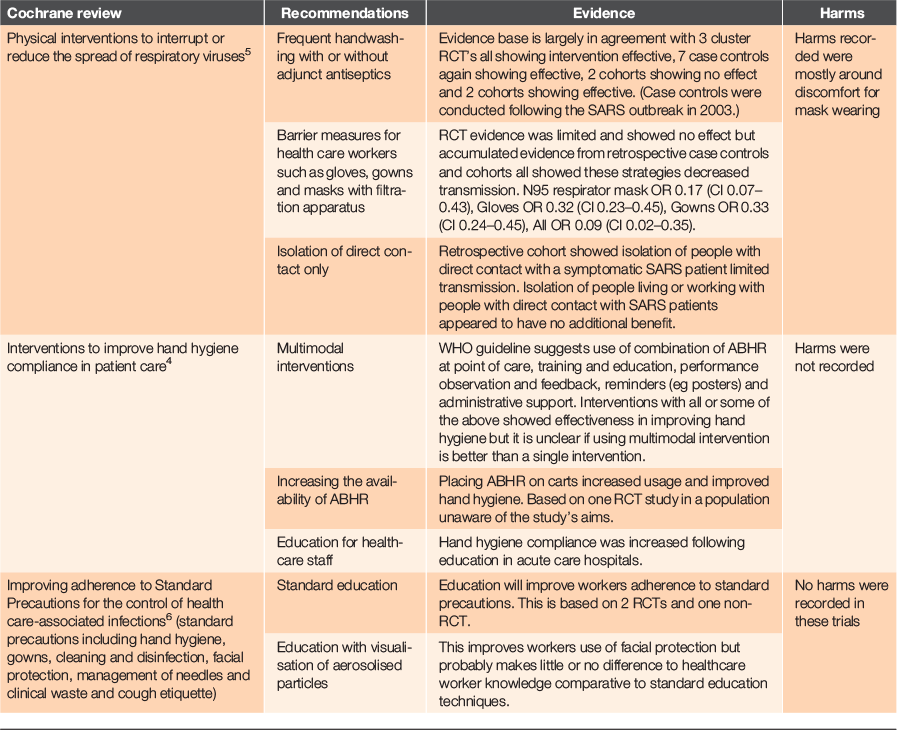Coronavirus (COVID-19): infection control and prevention measures
Vanessa Jordan 1New Zealand Cochrane Fellow, University of Auckland, Auckland, New Zealand. Email: v.jordan@auckland.ac.nz
Journal of Primary Health Care 12(1) 96-97 https://doi.org/10.1071/HC15950
Published: 30 March 2020
Journal Compilation © Royal New Zealand College of General Practitioners 2020 This is an open access article licensed under a Creative Commons Attribution-NonCommercial-NoDerivatives 4.0 International License
Cochrane Special Collection: https://www.cochranelibrary.com/collections/doi/SC000040/full1
Background: A pneumonia of unknown cause was first reported on 31 December 2019.2 On 30 January 2020 the outbreak was declared a Public Health Emergency of International concern. On 11 February 2020 the World Health Organization (WHO) announced a name for this novel virus COVID-19 and on 7 March the WHO marked the milestone of 100,000 confirmed cases worldwide.2 There is consensus that eventually Covid-19 will become the fifth circulating human coronavirus.3 However, in the short-term the main objective is to slow its transmission and protect the most vulnerable people, thus allowing health systems to cope with this novel virus. Cochrane has put together a special collection using all the systematic reviews assessing infection control in order provide the best evidence for those coping with this situation.1
Clinical Bottom Line: Handwashing and the use of alcohol-based hand rub (ABHR) are the simplest and most effective ways to prevent the spread of respiratory infections.4,5 Barrier measures such as the use of masks, gloves and gowns by health workers are also effective ways of reducing transmission.5 It would be prudent and would help adherence to standard procedures to remind healthcare workers of standard healthcare precautions to reduce transmission.6 Increasing the visibility and availability of handwashing stations and ABHR is beneficial and reduces transmission.4

|
References
[1] Cochrane Library. Coronavirus (COVID-19): infection control and prevention measures. 2020 [cited 2020 March 11]; Available from: https://www.cochranelibrary.com/collections/doi/SC000040/full.[2] World Health Organisation. Novel-coronavirus-2019. 2020 [cited 2020 March 11]; Available from: https://www.who.int/emergencies/diseases/novel-coronavirus-2019/events-as-they-happen.
[3] Day M. Covid-19: surge in cases in Italy and South Korea makes pandemic look more likely. BMJ. 2020; 368 m751
| Covid-19: surge in cases in Italy and South Korea makes pandemic look more likely.Crossref | GoogleScholarGoogle Scholar | 32098875PubMed |
[4] Gould DJ, Moralejo D, Drey N, et al. Interventions to improve hand hygiene compliance in patient care. Cochrane Database Syst Rev. 2017; CD005186
| Interventions to improve hand hygiene compliance in patient care.Crossref | GoogleScholarGoogle Scholar | 28862335PubMed |
[5] Jefferson T, Del Mar CB, Dooley L, et al. Physical interventions to interrupt or reduce the spread of respiratory viruses. Cochrane Database Syst Rev. 2011; CD006207
| Physical interventions to interrupt or reduce the spread of respiratory viruses.Crossref | GoogleScholarGoogle Scholar | 21735402PubMed |
[6] Moralejo D, El Dib R, Prata RA, Barretti P, Corrêa I. Improving adherence to Standard Precautions for the control of health care‐associated infections. Cochrane Database Syst Rev. 2018; CD010768
| Improving adherence to Standard Precautions for the control of health care‐associated infections.Crossref | GoogleScholarGoogle Scholar | 29481693PubMed |


